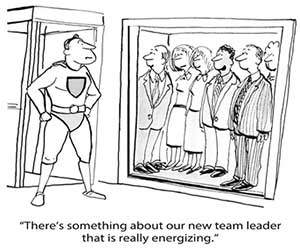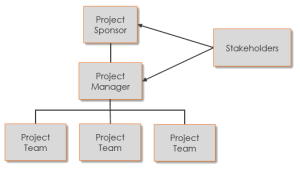
Although projects span a huge spectrum from big to small, innovative to routine, and technical to repetitive, there is in fact a standard project organization chart within which all projects fall. With the exception of a few variable parts all project fit into a standard mold. According to project management theory, each member of a project is, in fact, very well defined, and in this post I will examine that structure.
Core Members
Firstly, let’s observe the most basic project organization chart. This is the minimum existential requirement to have a project.
 Project Sponsor
Project Sponsor
This person is one level above the project manager. They are the person to whom the project’s “deliverables” are delivered. They are not directly involved with the project’s day to day execution, but they usually have some form of responsibility for the success and/or failure of the project. They often have a say in major project decisions and have an ongoing awareness of the project’s status. They usually act as an information source to senior management so that the project manager can focus on managing the project.
The project sponsor is the organizational contact for the project. Before the project was initiated they were probably the central point of contact and planning authority. Often they were in a “project champion” role, making presentations and drumming up support for the project.
They often deal with funding for the project, ensuring budgets are in place and payments are made throughout the duration of the project.
They can be internal or external to the organization carrying out the project. A common organizational structure is to have the project sponsor as part of an “owner” organization, such as an oil company, and the project manager and project team within a “consultant” organization, like an engineering firm.
Project Manager
The project manager is the person that handles the day to day administration of the project and project team and is ultimately accountable for the project’s success. They are the superhero who must make sure the deliverables are produced on time, on budget, on quality, and with all stakeholders are satisfied. Sometimes it does take a superhero doesn’t it?
They can be from the same organization or a different one, as is often the case with a vendor organization that was contracted to produce a set of deliverables.
The project manager is responsible for planning the project and then ensuring the project stays within the plan. If changes need to be made, the project manager generally requests changes from the project sponsor, especially if there is time or more money involved.
Sometimes the project is managed by a team, particularly on large industrial or oilfield projects. In this case there must a lead project manager, and the other project managers produce the project management documents such as schedules, estimates, quality criteria, risk analyses, and so forth.
Project Team
This group carries out the project work. They produce the project’s deliverables and perform the tasks necessary to finish the project. Although they are normally in a position to take responsibility for their work, it is project manager who ultimately must take responsibility for the success or failure of the project.
 Stakeholders
Stakeholders
Every project has someone who has an interest in its outcome, in other words, a stakeholder. As a minimum the project sponsor could be considered a stakeholder because they are expecting the deliverables at a certain time, budget, and quality level. In my experience only very small projects have no other stakeholders, for example pouring a driveway (although you could argue the neighbors are stakeholders as well as the city who required a building permit).
It is the project manager’s job to know all the stakeholders, no matter how insignificant, and ensure their approval is earned. Some stakeholders are supporters, such as local business groups for a new stadium. Some are opposed, like environmental groups, and some simply wish to keep informed of the status, like city building permit officials. Their position can, of course, change if their needs are not met by the project manager.
Non-Core Members
Although the above organization chart is the minimum requirement, there are a few other roles which exist on some projects:
- Clients, customers, and end users. These are the ultimate purchasers of the products or services which the project produces. Often these don’t formally exist because the project sponsor can serve exclusively in this role, such as for an oil well drilling project. If they do, however, they will indirectly dictate project criteria like quality standards, budgets, and grade (or specs and feature lists). Often the project needs to incorporate market testing or other customer response surveys which make them a core part of the project.
- Investors. Often the project manager must keep investors informed of the status of the project.
- Vendors. Many projects outsource project work to other firms. These firms require active management by the procuring organization to ensure the quality level, timeliness, and budgets are kept within expectations.
- Organizational Groups. Many projects affect other areas of the organization. Functional managers lend project staff, safety coordinators have their hand in the day to day work, financial people want interim updates, and the list goes on.
- Regulatory Agencies. Government regulations must be complied with, and this often has a substantial impact to the project, either cost, time, or both.
- Major Stakeholders. I’ve managed projects where our engineering firm was subcontracted to perform most of the work to produce a deliverable. In this case the prime contractor is an important stakeholder in the project, including financial interest, but simply needs to be kept informed and wants to ensure the project goes smoothly.
Project Organization Chart within the Project Management Plan
The Project Management Body of Knowledge (PMBOK) requires that the core project members are identified within the project management plan. This should take place near the beginning of the document and its format is very simple. It should be a bulleted or tabled list of all the project members, including full contact information so that the project management plan can serve as the central project reference. A graphical organization chart looks great but is not necessary.






